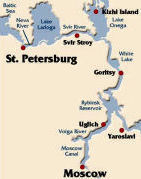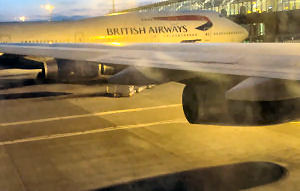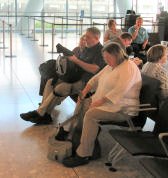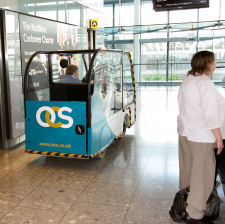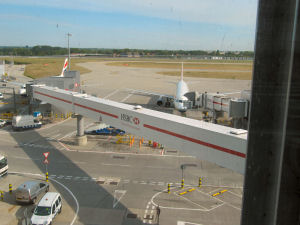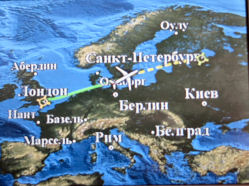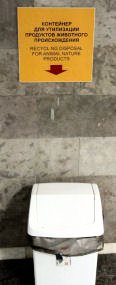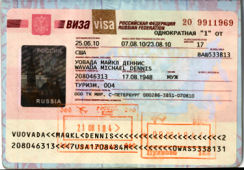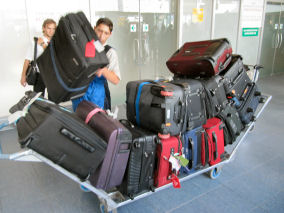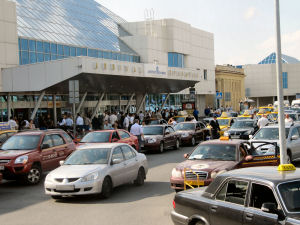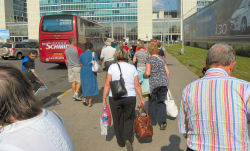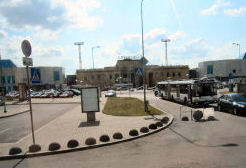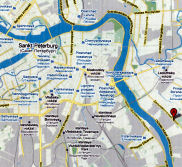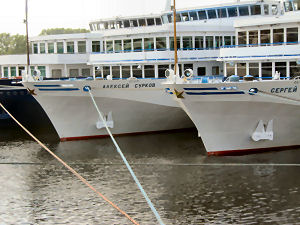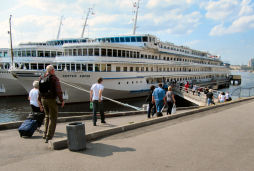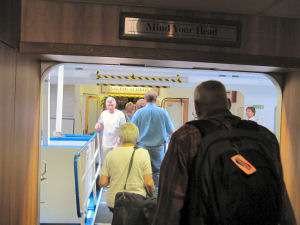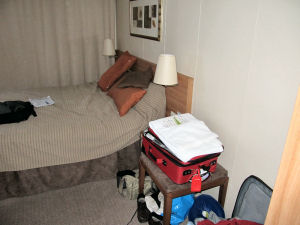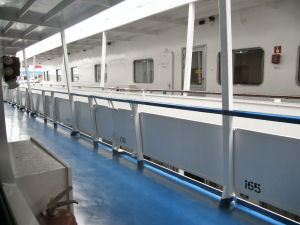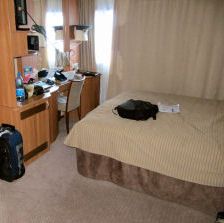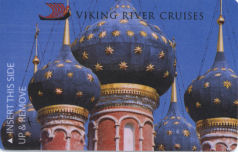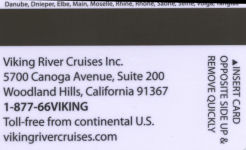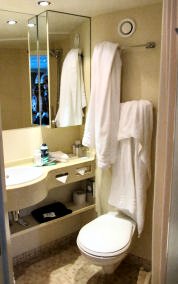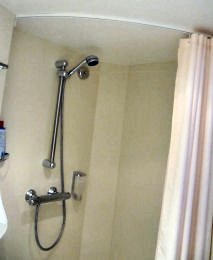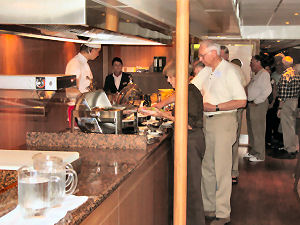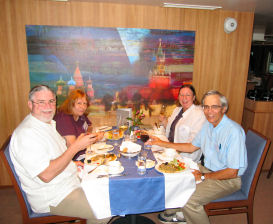The most obvious things to photograph were the duty-free shops. The one nearest us sold Chanel watches. Perhaps twenty or thirty outrageously priced timepieces were on display in the little windows. Inside was nothing but a desk and the shopkeeper. We sat there for almost four hours, and no potential customers ever entered the shop, which had see-through walls.
Occasionally I was tempted to snap a photo of something a little unusual, but in the end I opted for husbanding whatever was left of my camera’s last remaining charged battery. I did not want to arrive in Russia with a camera full of airport photos that no longer functioned. At one point a group of young ladies wearing long wrap-around robes and head scarves seated themselves near us. I guessed that they must have been Muslims. They often giggled and took photos of one another. I expected them to be more somber. Live and learn.By 8:00 there were no empty seats in the waiting area. We were bored out of our gourds, but at least we had a place to park our tired carcasses. At one point I got hungry and ate my muffin. Sue and Patti came back just before they posted the gate for our plane. I did not ask where they had been, but Sue said that they had found much more comfortable chairs.
For some reason we had to go through security again. The British let you keep your shoes on. It occurred to me that Richard Reid was a native of London, although his famous flight originated in Paris.The Airbus A320 to St. Petersburg was completely full. The four of us were spread throughout the plane. My seat assignment was 12E, a middle seat just behind the exit rows. I dozed off and missed the takeoff entirely.[1]
Almost as soon as the seatbelt light was extinguished, the flight attendants began to serve breakfast, which included scrambled eggs, sausage, ham, mushrooms, and tomatoes. On the side were bread with marmalade, fruit – blackberries with slices of something – yogurt, orange juice, and coffee or tea. It was truly delicious, but they were a little slow in picking up the trays after we had finished eating.
There was one peculiar note: the young man in the window seat next to me sniffed each item of food before he ate or drank it. Everything apparently passed his nose test. I had forgotten how good British breakfasts were. We were lucky that the airline elected to serve breakfast. The flight was only three hours in duration, but we also lost three hours. So, we would not be landing until about 3:30 local time. They easily could have decided to serve lunch, a meal for which the Brits are not so renowned. I was still too spaced-out to do much constructive. I had an enjoyable time playing with the flight map on the screen in front of me. It showed all of the information in English and then in Russian. I tried to translate the Russian versions and was pretty successful. I also tried to take a usable photo.In order to enter Russia in 2010, you needed to purchase a visa. This involved filling out a convoluted form and sending it with your passport and photos to a company that walked it over to the Russian embassy in Washington. They then sent your passport complete with visa back to you.
Before we landed, the flight attendants distributed “cards” to be filled out. For some reason the fellow to my right indicated that he did not need one. The “card” was actually a perforated sheet of paper with two forms, one for entry into Russia and one for exiting. The information required on each side was the same. The print was very small. For the most part the form was not too bad, but the area for the visa number had two lines. I examined the visa page of my passport. There was a stamped number at the top and another number labeled “visa number.” I decided to enter one on one line and the other on the second line.
The area around St. Petersburg finally came into view. The very first thing Russian that I saw was a power plant. The rest of the scenery seemed mundane; nothing else seized my attention before we touched down at Pulkovo Airport, which is due south of St. Petersburg, almost to Pushkin. I was extremely surprised at how rinky-dink it seemed. There appeared to be little more than a few runways in the middle of a field. The interior was little better. It reminded me of the airport in Istanbul, but that memory was fifteen or sixteen years old. I expected something more modern in Russia’s second city. My first encounter with an actual Russian citizen was definitely a positive one. Not only did the agent at passport control accept my documents without questioning, she was also very cute. I did not catch her name or patronymic, but she wore two stars on her epaulet. All four members of the Connecticut contingent found their luggage with no difficulty at all, which proved that British Airways can successfully deliver luggage to a connecting flight in less than four hours. We detected no security to speak of after we picked up our luggage. I wondered if the Communists had let foreigners in so easily. We exited the baggage claim area, and the resemblance to Istanbul was striking. People were lined up several deep around the doorway. This time, however, they were not family members but professional people attempting to connect with individuals and groups. We had no trouble finding the Viking representative, whom we would come to know as Gennady the tour guide. The porters (or maybe sailors) loaded our luggage onto carts. We had to mill around in the airport terminal until Gennady was satisfied that everyone had been accounted for. The terminal was not air conditioned, and even I felt a little hot and thirsty. Tom asked me what the Russian word was for water (вода – vuh DAH) and went to a store twenty or thirty yards from the place in which we were congregating in order to buy a bottle. He almost missed our group’s exodus from the terminal.After another short wait in the parking lot, thirty of us (including the gentleman who sat in the aisle seat next to me on the plane and his wife) took the bus to our ship, the Aleksei Surkov. Viking has its own river port on the Neva River in St. Petersburg on Октябрьская набержная (October quay), about five miles – as the crow flies – southeast of the center of the city. It was on the wrong side of the Neva, however. Regardless off the destination, a bridge crossing was inevitable.
Six Viking ships were in port. We needed to walk through the Sergei Kirov[2] to get to the Surkov. Another ship was moored on the river side of ours. So, the passengers on that ship had to walk through two ships. Gennady told us not to worry about our luggage. He was right; it somehow made its way to our cabin without our assistance.As soon as we boarded the ship, two young ladies made us welcome with small glasses of some kind (cranberry?) of juice and hot rags when we arrived. That reminded me. British Airways had not even given us the option of using hot rags before we consumed our meals. No wonder I felt like a peasant.
I was only moderately surprised that they retained our passports and airline tickets when we checked in. In exchange we each received a blue key card with a photo of onion domes on it. Sue did not like the idea of surrendering our documents, but for me it meant that there would be one less thing to lose.
We were in cabin #322, which was right next to the stairs and directly over the reception area. I later ascertained that we were on the fore-starboard side. Patti and Tom were across the hall in 323. These were very nice cabins, not at all like the walk-in closets assigned to us on our Caribbean cruises. The bathrooms were fully as spacious as those of most European hotel rooms. The most amazing thing was that they looked just like the pictures on the Viking website. Even the air conditioning was more than adequate. I decided to let Sue keep the cabin as cool as she wanted it. I could always put on my jacket. The first thing that I noticed when I unpacked the big red suitcase was that I had forgotten to throw in the two pairs of long pants[3] that I had intended to bring. I only had two pairs of shorts, one pair of Dockers that I had worn on the plane, and my nylon warm-ups. It would be difficult to maintain my high standards of fashion under these circumstances, but I would just have to make do. I must say that I took this with remarkable aplomb. On previous trips I might have been really been upset at myself. I also had difficulty finding the battery charger for my camera. Having no pants to wear is one thing, but losing my battery charger would have been a disaster of the first order. Although I clearly remembered tossing the charger into my suitcase, I was on the verge of despair when it finally turned up inside one of the mesh pockets of my suitcase. I immediately plugged it in and began recharging one of my batteries. Another surprising aspect of the layout of the cabin was that it had plenty of electrical outlets. One of them even had an American interface. That was a big surprise. The people at the registration desk had provided us with name tags. I decided that I would wear my name tag for the first day or two at least or until I lost it.Tom immediately set off to locate the ship’s bars. He has been known to enjoy quaffing a beer on occasion. He reported that the staff members in the bar addressed him as Sir Thomas. He was tickled with that. I told him that he should have insisted that they address him as Lord Thomas.
Our first official gathering was an orientation meeting run by the cruise director, whose name was Konstantin. He explained that the currency on the ship was the “unit,” where one unit was equal to one euro. Anyone could purchase the unlimited drinking package for 260 units, which at the current exchange rates came to about $338. This figure looked more like an annual liquor budget for me, but Tom gave the proposition some consideration. Konstantin also outlined the schedule for the next few days. On Tuesday we were scheduled to visit the Hermitage and to see a performance of Tchaikovsky’s Swan Lake. Konstantin indicated that we should probably try to obtain a quantity of rubles at an ATM on Tuesday. The ruble was then worth a little more than three cents, so $200 should buy approximately six thousand rubles. I tried to come up with a quick way of mentally converting rubles to dollars and vice-versa, but I seldom succeeded. Konstantin also provided us with forms on which we were asked to designate which optional excursions in St. Petersburg we wanted to participate in. The choices were a Cossack show, the Peterhof Palace, a canal tour, a “shuttle bus,” which was just transportation to and from the city with two hours of free time, and the Yusupov Palace. On the day after we left St. Petersburg, there was also an optional class in painting of the Russian nesting doll known as a матрёшка (muh TRYOSH kuh). The canal tour, shuttle bus, and Yusupov Palace tours were simultaneous. You could only select one.As I prepared for our first meal onboard, I was unable to locate my comb. Evidently it had fallen out of my pocket at some point during the trip.[4] I had thoughtfully included a spare in my shaving kit, but I certainly did not expect to draft it into service so early in the trip. If I lost this one, I might look like Don King by the end of the second week.
Supper that evening was, for the only time on the trip, served buffet-style: salad, Beef Stroganoff and vegetable lasagne. I thought that the Stroganoff was mediocre at best, but Sue later informed me that you had to add the sour cream, which was in a nearby dish, yourself. So, my judgment was worthless. We were provided with free wine at dinner. Although I could have sworn that they said that this would be the only such occasion, in fact we had complimentary wine at every supper. Dessert was a choice between chocolate mousse and ice cream. I chose the former, but everyone seemed to think that the ice cream was better. Oliver, the restaurant manager, took our photo.During dinner I regaled everyone with the joke that I had heard a week earlier on Car Talk about the cowboy and the business consultant. If the Magliozzi Brothers have not taken down the web page, you can read it here.I started to download my photos from the camera to the Netbook. I soon realized that I had forgotten to install the new Canon software on the Netbook. So, I had to cut and paste the images from the camera to my hard drive, and I would not be able to use the slide show feature of the Canon software because it would not create the thumbnails. Not a disaster. In a way it was an advantage to be able to designate which folders the photos were added to.
The reception for the ship’s free wireless Internet was nearly intolerable in the cabin, but I managed to get out a short e-mail to Denise and another to my dad with AT&T’s web-mail feature. The Internet connection was a pretty big disappointment. I had fostered high hopes that the ship would have a decent wireless arrangement. The shower was pretty good, but I had a hard time figuring out how to use the controls. The dials were on either side of the horizontal column. The temperature was controlled by the right one, and the intensity by the left. Needless to say, it had the detachable shower head that seemed ubiquitous in Europe.I was uncertain whether I would like a river cruise or not. It appeared to be halfway between an intimate bus tour and an impersonal sea cruise. I resolved to do everything I could to get the most out of it. On paper it appeared to be the best way to become acquainted with Russia in only two weeks.
The bed was very comfortable. In lieu of a top sheet it had a puff similar to what we had encountered in the Dolomites. I used the red eye mask from a previous trip and the yellow earplugs that British Air had provided. I fell asleep seconds after my head touched the pillow.
[1] If you are wondering why four people who made their reservations months in advance were not sitting together, you will have to ask Sue (chachasue@aol.com). My clear understanding is that it was my fault, but I am not sure whether mine was a sin of omission or commission.
[2] Kirov, whose real name was Sergei Mironovich Kostrikov, was one of the very few Bolshevik leaders who was still widely respected in Russia. He ran the Leningrad (St. Petersburg) district of the Communist Party for eight years and was extremely popular. He was murdered in 1934, and most historians now think that Stalin ordered the assassination.
[3] This was only half as bad as I thought. One of the missing pairs of pants was ripped through in the left rear by the pocket in which I customarily carried my wallet. I discovered this just after going through security at the airport on a one-day trip to see a prospective client.
[4] No, it didn't. I found the comb in the pocket of my blue shorts when I returned to Connecticut.
